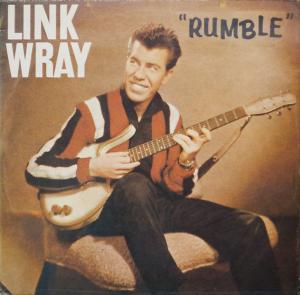When you think of rock 'n' roll, there's an undeniable pulse—a rhythmic heartbeat driving the energy of countless tracks. One of the most iconic songs that encapsulates this essence is "Rumble" by Link Wray. Released in 1958, "Rumble" is not just a song; it's a cultural milestone that paved the way for the sound of rock music as we know it today. With its haunting melody and powerful guitar riffs, "
First and foremost, "Rumble" represents a shift in the evolution of rock guitar. Link Wray employed distortion and feedback, experimenting with sounds that were groundbreaking at the time.
- Influence on Rock 'n' Roll: "Rumble" is considered one of the first examples of instrumental rock music, influencing countless artists and bands, from the Kingsmen to the Who.
- Musical Innovation: The use of power chords and the fusion of different musical styles were revolutionary, paving the way for genres such as punk and heavy metal.
- Cultural Impact: The song's raw energy resonated with the youth of the time and became associated with the rebellious spirit of rock music.
Ultimately, "Rumble" isn't just a note on a musical score; it’s a testament to the daring creativity that defines the world of music. Embracing its influence is like tracing the roots of modern rock back to its vibrant source.
Getting Started: Required Equipment and Setup

Alright, so you're ready to jump into the world of "Rumble" and bring its iconic riffs to life! Before you grab your guitar and start strumming your heart out, let’s make sure you have the right equipment and setup. Here’s a friendly dive into what you’ll need.
Essential Gear
- Electric Guitar: A solid-body electric guitar is key to achieving that punchy sound that "Rumble" is known for. Brands like Fender or Gibson are popular, but any quality electric guitar will do.
- Amplifier: For those rich, distorted tones, a tube amplifier is ideal. Look for one with decent wattage that can handle both home practice and gigs.
- Effects Pedals: To recreate the unique sound of "Rumble," consider using a distortion pedal or an overdrive pedal to boost the gain.
Setting Up Your Space
Creating the right atmosphere is just as important as having the gear. Here’s how you can set up:
- Location: Choose a space that’s quiet and free of distractions. A dedicated practice room works wonders!
- Lighting: While practicing, good lighting helps you see your fretboard clearly, reducing strain on your eyes.
- Seating: Don’t forget a comfortable chair! You might be jamming for hours, so make sure it’s supportive!
With the right equipment and a cozy setup, you're one step closer to mastering "Rumble." So, plug in and let those iconic riffs come to life!
Understanding the Song Structure
When diving into "Rumble" by Link Wray, it's essential to grasp its song structure, which is not only straightforward but also contributes to its iconic status in rock history. Unlike many popular songs, "Rumble" doesn’t follow the typical verse-chorus setup. Instead, it leans into a more primitive arrangement that captures raw energy and intensity. Here’s a breakdown of its structure:
- Intro: The song kicks off with a distinctive guitar riff that immediately sets the mood. This intro grabs the listener's attention and establishes the tone.
- Verse: The main riff repeats along with a simple rhythm that builds the foundation. The energy stays consistent, drawing the listener deeper into the gritty sound.
- Bridge: This part provides a slight variation, allowing for a dynamic shift that keeps the listener engaged. It’s crucial for adding interest without straying too far from the central theme.
- Outro: The song concludes by revisiting the central riff, leaving a lasting impression. This circular structure enhances the song’s memorability.
Understanding this layout allows guitarists and fans alike to appreciate how Link Wray's minimalistic approach leads to such a powerful impact. It's a reminder that sometimes less really is more!
Step-by-Step Breakdown of Guitar Riffs
Now, let’s get right into the groove of "Rumble"! The iconic guitar riffs are what make this track unforgettable. Below, I’ll break down the primary riff into manageable steps, making it easy for you to follow along.
- Get Your Gear Ready: Make sure you're using an electric guitar, ideally with a bit of distortion to capture that gritty sound. A tube amp can help emulate Wray’s vintage tone!
- Tuning: Tune your guitar to standard tuning (E A D G B E). This way, you can replicate the original sound exactly.
- The Main Riff: Start with the first few notes. The riff primarily revolves around power chords and slides.
- Begin on the 5th fret of the low E string and slide to the 7th fret.
- Next, play the 5th fret on the A string while following through with the rhythm.
- Expanding the Riff: Once you have the foundational power chords down, add in palm muting to create that percussive sound that’s signature to Wray's style.
- Practice with Timing: The key to mastering this riff is to get the timing right. Practice slowly at first and gradually increase your speed. It's all about feeling the groove!
By breaking it down this way, you'll find that each riff isn't just a series of notes, but part of a larger whole that embodies the essence of rock 'n' roll. Happy playing!
Techniques to Enhance Your Playing
Mastering "Rumble" by Link Wray isn’t just about hitting the right notes; it’s about embodying the raw energy and vibe that the song emanates. Here are some techniques you can incorporate into your playing to truly capture that iconic sound.
- Power Chords: Focus on playing power chords, which are fundamental in rock music. In "Rumble," the use of dynamic power chords gives the song its driving force. Try practicing these shapes:
- Palm Muting: This technique is crucial in imitating Link Wray’s gritty sound. By resting your palm lightly on the strings near the bridge while you strum, you can create a percussive sound that adds a layer of intensity.
- Volume Control: Use your guitar’s volume knob to produce a wide range of dynamics. Experiment with rolling it back for softer tones and cranking it up for that fierce, edgy sound.
- Feedback and Sustain: Link Wray was known for his innovative use of feedback. Set your amp at a high volume and find the sweet spot to let those natural overtones sing, especially during the darker parts of the song.
| Chord | Fret Position |
|---|---|
| E5 | Open E string + 2nd A and D strings |
| A5 | Open A string + 2nd D and G strings |
By grasping these techniques, you can elevate your rendition of "Rumble" and bring it to life in a way that truly honors Link Wray's legacy.
Tips for Practicing Rumble Effectively
Practicing "Rumble" requires focus and a strategic approach. To truly embrace the essence of this classic, here are some tips to make your practice sessions more effective:
- Break It Down: Start by breaking the song into smaller sections. Tackle one riff or phrase at a time, which makes it easier to master each part before stringing them together.
- Use a Metronome: Keeping time is essential, especially when it comes to the driving beat of "Rumble." Start slow to ensure accuracy, then gradually increase the tempo as you become more comfortable.
- Listen and Emulate: One of the best ways to understand the nuances of "Rumble" is to listen to the original recording. Pay attention to the dynamics and phrasing; try to replicate the feel Link Wray brought to the table.
- Record Yourself: Sometimes you can’t see the forest for the trees. Recording your practice allows you to listen critically and identify areas for improvement.
- Consistent Practice: Make it a habit. Aim for short, daily sessions instead of sporadic long ones. This builds muscle memory and helps you retain what you’ve learned.
With these tips in your toolkit, you’ll be well on your way to mastering "Rumble" and adding your unique touch to this timeless classic.
7. Exploring Other Notable Covers and Influences
When it comes to iconic tracks like "Rumble" by Link Wray, it's fascinating to dive into the variety of covers and how the song has influenced countless artists across different genres. The raw energy and unique sound of "Rumble" has made it a popular choice for musicians who want to pay homage to its unmistakable riffs.
Some notable covers include:
- The Ventures: This instrumental rock group produced a memorable version in the 1960s that introduced "Rumble" to a wider audience. Their smooth guitar tones and tight arrangements showcased the song's inherent power while adding their unique flair.
- The Mooney Suzuki: In the early 2000s, this garage rock band covered "Rumble" with an edgy twist, channeling the raw angst of the original while infusing it with modern energy.
- Jonathan Richman: A folk-rock artist who is known for his eccentric style, Richman's cover of "Rumble" reflects his playful approach to music without losing the essence of the song.
Moreover, the influence of "Rumble" extends beyond direct covers. Its guitar riffs have inspired numerous artists, including famous names in the punk and rock scene, solidifying its place in music history. For instance, many rock guitarists have cited Link Wray as a pioneer of guitar distortion and power chords, which have shaped the sound of many subgenres, from punk rock to heavy metal.
All these interpretations and influences are testaments to how "Rumble" has transcended its era, continuing to resonate with artists and music lovers alike.
8. Conclusion and Final Thoughts
In wrapping up our exploration of "Rumble" by Link Wray, it's clear that this track is so much more than just a song—it's a cultural phenomenon that helped redefine the role of the electric guitar in rock music. With its distinctive sound and raw power, "Rumble" paved the way for future generations of guitarists, influencing the fabric of rock, punk, and beyond.
Link Wray's innovative techniques, especially his use of distortion and feedback, became a blueprint for aspiring musicians. Here are some final takeaways:
- *Iconic Riffs: The main riff of "Rumble" is not only catchy but has also become a staple for guitar players. It serves as an excellent study piece for anyone wanting to master electric guitar techniques.
- Cultural Impact: "Rumble" has been featured in various films and television shows, becoming synonymous with themes of rebellion, youth culture, and the raw energy of rock music.
- Legacy*: Link Wray's influence can be seen in the works of countless artists from different genres, emphasizing the timeless nature of his music.
So, whether you're a seasoned musician or just someone who loves good music, "Rumble" provides an enduring reminder of the power of a simple guitar riff to evoke emotion and captivate audiences. Embrace the legacy of Link Wray and continue to explore the depths of rock guitar history!










